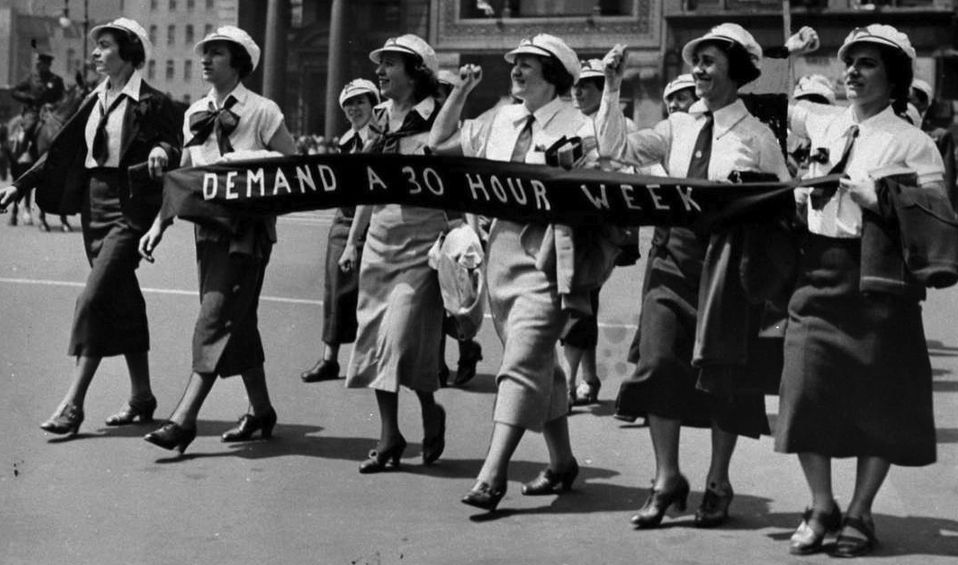There was that old Victorian, moralistic saying of drink being the curse of the working classes. Oscar Wilde wittily turned it around to read that work is the curse of the drinking classes. Can we consider work as a curse? A recent US survey found that 36 percent loved their job and was meaningful, nearly 14 percent gave a neutral reply and the rest said that their occupation had no meaning. Up to 40 percent of us secretly believe our jobs probably aren’t necessary. In other words, they are “bullshit” jobs, to use the phrase of the late David Graeber. Whether we refer to it as the rat race or the daily grind, we celebrate what previous generations have fought for – the weekend and TGIF. Unsurprisingly, money is the great motivator to work and pay is the reason cited most often for accepting a new job – but not by a landslide. After compensation, people were most likely to leave because they didn’t find their work interesting, followed closely by not feeling respected, and by lack of opportunity.
Marx didn’t see work as intrinsically unpleasant – rather, he diagnosed it as a problem under capitalism. He emphasized two reasons why capitalism “robs workers of all life content” or leads to alienation. The first is that it is an economic system that accentuates the division of labour, breaking production into a series of smaller and smaller, more specialized tasks, each performed by a different kind of worker, because this will increase profitability. As a result, “the individual labourers are appropriated by a one-sided function and annexed to it for life,” depriving them of the well-rounded variety of powers and activities that they need to be full human beings. The second reason why capitalism generates alienation is that it is an economic system in which a small minority controls the means of production, and in which most people can survive only by selling their own labour power. Workers under capitalism have to work for someone else. As a consequence, Marx argues that work has little or no intrinsic worth for the worker – as he puts it, “it is not the satisfaction of a need but a mere means to satisfy needs outside itself.”
Undoubtedly, in the years since Marx was writing, the nature and conditions of work in modern industrial societies have changed, largely for the better. Reductions in the hours of work, regulations for health and safety, and vacation time have all come about through the pressure of trade unions (strikes/protests) and workers’ parties (pushing for legislative changes). Still, from factory to retail to office drudgery, to endless form-filling and unachievable targets, to the gig sector, there is a substantial number of workers who would come under the category of “alienated labour.”
Despite the last 100 years seeing progress in the area of shortened work hours, capitalism has also got software to follow every keystroke on a computer and have tracking mechanisms to monitor every movement of Amazon workers. In recent years, working hours for many workers has crept back up. Furthermore, there is a link to work and physical and mental health. The stereotypical image of the high-powered, stressed-out corporate executive succumbing to a heart attack at work is false. Research shows that it is the low-ranking worker, having little or no autonomy, who is more likely to die of a heart attack.
So, if workers feel alienation, would working fewer hours lead to less alienation? The vast majority of workers (even those who enjoy their jobs) would salivate at the prospect of a three- or four-day week – so long as wage cuts were not on the agenda. We were not made to work long hours. If we look back at our ancestors, the hunter-gatherers, they needed only to work about fifteen to twenty hours a week (not including time for food preparation). Anthropologists have called these the original affluent societies.
Live to work or work to live?
The argument is that hunter-gatherer societies were able to achieve affluence by desiring little and meeting those needs and desires with what was available to them without suffering deprivation. Referring to these societies as “a model” doesn’t imply an argument to give up the material gains of modern society and engage in “the simple life” of a hippy, agricultural lifestyle – not that such a reversal would be possible or desirable. Does anyone seriously want to live in a world without steel or medicine?
The work-life balance of these early societies does raise the question: do we live to work or do we work to live? The answer to that question depends on social and material conditions. A long time has passed since the hunter-gatherer era in most places of the world. Over 12,000 years, humanity has passed through agricultural settlements and feudalism to end up with capitalism for the last two centuries. Many assume that the increased labour times in industrial societies are a necessary trade-off in return for our longer lives and abundance of material goods. But that is wrong. Between 1951 and 2007, productivity in the US rose by 400 percent. Had that increase been applied to benefit American workers, the average worker could achieve a 1950s standard of living with an 11-hour working week. Futurists and economists, basing themselves on the expansion of the economy and the development of technology (but not on the laws of capitalism!), have been predicting for years that the hours of the working week could be cut in half and more. The economist John Maynard Keynes predicted, in 1930, that his grandchildren would work just 15 hours a week, envisaging working Monday and Tuesday, with a five-day weekend. The futurists of the 1960s, with the coming of robots and other new technology, were predicting a work week of 10 hours. Somehow capitalism robbed workers of all these hours.
History of struggles for the shorter work week – 19th Century
To understand why these predictions didn’t materialize it helps to look at history. The 8-hour workday was the iconic demand of socialists and the labour movement during the 19th Century as the industrial revolution progressed. At that time, the working day could range from 10 to 16 hours. The work week was typically six days a week and the use of child labour was common. Robert Owen had raised the demand for a ten-hour day in 1810 and instituted it in his “socialist” enterprise at New Lanark, Scotland. By 1817 he had formulated the goal of the eight-hour day and coined the slogan: “Eight hours’ labour, Eight hours’ recreation, Eight hours’ rest.” Women and children in England were granted the ten-hour day in 1847.
A shorter working day and improved working conditions were part of the general protests and agitation for the working-class Chartist movement and the early trade unions in England. The International Workingmen’s Association, heavily influenced by Karl Marx, took up the demand for an eight-hour day at its Congress in 1866, declaring, “The legal limitation of the working day is a preliminary condition without which all further attempts at improvements and emancipation of the working class prove abortive,” and “The Congress proposes eight hours as the legal limit of the working day.” Karl Marx saw it as of vital importance to workers’ health, writing in 1867: “By extending the working day, therefore, capitalist production…not only produces a deterioration of human labour power by robbing it of its normal moral and physical conditions of development and activity, but also produces the premature exhaustion and death of this labour power itself.”
In 1872, workers in the Ontario industrial towns and in Montréal rallied behind the Nine-Hour Movement, which sought to reduce the working day from 12 to 9 hours. The movement was unsuccessful, but it did lead to the formation of the short-lived Canadian Labour Union (the first national federation). In the US, in 1886, there was the heroic movement of the workers assembling at Haymarket Square in Chicago. It began as a peaceful rally in support of workers striking for an eight-hour workday, the day after police killed one and injured several workers. At the end of the rally an unidentified person threw a bomb at the police who had come to disperse the rally. Eight police died and eight men, labelled as anarchists, were convicted and sentenced to death in a rigged trial; four were executed. Three years later, inspired by “the Haymarket affair,” the newly established Second International adopted a resolution for a “great international demonstration” in support of working-class demands for the eight-hour day. The date chosen was May 1. May Day subsequently became an annual event.
20th Century to today
In 1914, emboldened by a dozen years of in-house research, Henry Ford famously took the radical step of doubling his workers’ pay, and cutting shifts in Ford plants from nine hours to eight. Both measures were brought about not by Ford’s humanity but by the realization that low pay and long hours were costing him big time in terms of worker turnover. The previous year, Ford had hired more than 52,000 men to keep a workforce of only 14,000. New workers required a costly break-in period. Over the next five years, Ford’s competitors adopted the same model after seeing his production soar. It was at this time that many companies maintained “if you wanted to keep your workers bright, healthy, productive, safe and efficient over a sustained stretch of time, you kept them to no more than 40 hours a week and eight hours a day.” Even the capitalists realised that you can take a horse to water but you can’t make him drink.
Employment Insurance was introduced in Canada in 1941. At the same time, the eight-hour workday and five-day work week began to spread as the norm, but it wasn’t till the early 1960s that Canada enshrined the eight-hour day into law. In the 1980s, as neo-liberal ideology took hold, work week reductions came to a grinding halt. Economic growth was translating not into more leisure, but into the production of more stuff. In most western countries, the work week stopped shrinking altogether. In the US, it actually grew. Seventy years after the country passed the 40-hour work week into law, three-quarters of the labour force was putting in more than 40 hours a week.
Even in countries that have seen a small reduction in the individual work week, families have nevertheless become more pressed for time. One important development was the feminist revolution. There were many different facets to this revolution (political, social, economic and cultural) but a significant component was the surge of women entering the work force. Women represented 47.4 percent of the labour force in 2019 compared to 30.3 percent in 1960. In the 1980s productivity gains stopped going to workers and at the same time wages stagnated. This is an important part of why women went to work: a single income for working class people could no longer support a family. Logic would suggest that more people in the work force would lead to workers, men and women, working fewer hours. But we’re dealing with capitalism, not logic. Capitalism requires continual growth in profits and continual increases in the production and sale of commodities. This requires hiring more workers and exploiting their labour. Reducing the hours they work is generally not conducive to that.
As many people across the globe move to working remotely to slow the spread of coronavirus, they’re also starting to work a longer day. Those in the US have logged on for an additional three hours per day compared to patterns seen before March 11 – a 40 percent jump – according to data from a virtual private network service provider. In the UK, France, Spain and Canada, the working day has extended by an average of two hours, with many people starting work earlier than usual. This is just an extension of a trend that had been developing in the pre-pandemic period – that workers, mainly in white collar jobs, were taking work home with them and were at the beck and call of a barrage of work related emails.
Are workers in favour?
The early phase of the COVID-19 crisis in March to May saw the unemployment rate rise to 13.7 percent. Three million jobs were lost over March and April, and about 2.5 million more had their hours slashed. With the re-opening of the economy in the summer the employment situation improved. However, the latest figures show that the overall employment number is still a million less than pre-pandemic levels. And with the surging of COVID cases, unemployment will increase again.
A shorter work week for all would mean a lower unemployment rate since more people could share in the overall workload. By reallocating part of the work to some and easing the pressure on others, this arrangement distributes the same amount of work among more employees. Is it time to switch to a four-day work week? For one company, the answer was yes. New Zealand financial services firm Perpetual Guardian in 2018 changed the schedule of 240 of its employees from a five-day to a four-day work week without changing their pay, to test the impact of having a shorter work week on productivity. They found that the change resulted in a 20 percent increase in productivity, without any drop off in output throughout the trial. They also saw a marked improvement in the engagement and well being of employees. When compared with the results of a 2017 trial, stress levels went down from 45 percent to 38 percent. The number of staff feeling their work and life were in balance jumped from 54 percent to 78 percent.
These results should come as no surprise. A recent survey conducted by the Angus Reid Institute found 53 percent of Canadians in favour of a four-day work week. The number of Canadians who are open to the arrangement has risen from 47 percent in 2018. Three in five Canadians who applied for CERB (58 percent) support the call for a shorter work week. And the idea is most popular among the working class: 64 percent of those who belong in the lowest household income levels agree with it, while 47 percent of those earning a household income of more than $150,000 are in favour. “Half (53 percent) say the concept has merit, well over double those who feel it is ill-conceived (22 percent),” Angus Reid reported.
The future – Robots, artificial intelligence and algorithms
Michael Roberts, the Marxist economist,has written, “The (current) slump will and is providing an opportunity for companies, particularly large ones, to do away with substantial parts of their labour force and replace them with machines, robots, home working connectivity and algorithms. The result is that there will be further concentration of companies in sectors, as larger companies devour the markets of the smaller. Of course, this is no new phenomenon but is part and parcel of slumps under capitalism…. The much talked about automation revolution is likely to take off, at least in some important growth sectors. Under capitalism … this will not mean fewer working hours for employees … On the contrary, the automation revolution under capitalism will aim to reduce the workforce, increase hours for those still employed and keep wages from rising – all in order to raise the profitability of the most efficient at the expense of the least efficient.”
“Estimates show that each multipurpose robot has replaced about 3.3 jobs in the US economy and reduced real wages. And forecasts for robot expansion in the 2020s predict exponential growth. The number of industrial robots has already increased from a little over one million operative units in 2010 to a projected 3.15 million units in 2020. Over the same time, robots reportedly became capable of substituting for, or even outperforming, humans for many tasks, such as producing customised parts and medical implants using 3D printing technologies, diagnosing diseases, and assisting decision making, for example, by ‘robot judges’.”
Isaac Asimov wrote the Zeroth Law of Robotics: “A robot may not injure humanity, or, through inaction, allow humanity to come to harm.” If only the laws of capitalism could be overridden to guarantee this outcome.
The future – a socialist society
If the trade unions were to boldly campaign for a four-day week, using the facts and figures and economic analysis that support the plan, it would receive a tremendous echo from workers. We, in Socialist Alternative, would go further. A four-day week would be a giant step forward but imagine if that could be accompanied by nationalization of the big companies under workers’ control. The workers would not only be working fewer hours, they would also be in control of decisions about the what and how of the business. Outside of work, they would have more time to pursue recreational and leisure pursuits, participate more in family life and engage in political and community activities.
If we could abolish capitalism and replace it with a society in which workers collectively and democratically control production, then work itself could be transformed into an activity that we would find rewarding for its own sake. It would become a way of exercising our individual creativity and talents, and of contributing to the common good. As Marx put it: “and therewith also the antithesis between mental and physical labour, has vanished; after labour has become not only a means of life but life’s prime want.”




